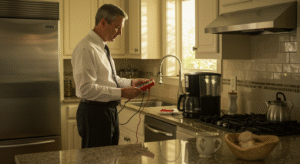Millions of homes face unexpected blackouts each year, and when the power goes out, so can your basic needs. Think spoiled groceries, unusable medical devices, dark hallways, and vanishing WiFi. That’s why calculating your emergency power needs—before a crisis hits—isn’t just smart. It’s essential.
Emergency power needs refer to the minimum electrical power your home requires during an outage to keep essential items running. Whether it’s a short blackout or a multi-day grid failure, knowing precisely how much power you’ll need can mean the difference between comfort and chaos. By calculating accurately, you avoid overspending on oversized equipment—or worse, underpowering during a critical moment.
Understanding Your Household Power Consumption
Start by identifying the devices you use every day. Common appliances such as refrigerators (600–800 watts), LED lights (5–20 watts each), televisions (100–300 watts), and WiFi routers (5–10 watts) all contribute to the household power load. Some items like electric stoves and HVAC systems demand significantly more power, often in the range of 2,000 to 5,000 watts.
It’s crucial to differentiate between average usage and peak load. A refrigerator may only use 700 watts on average, but it needs a temporary surge of power—sometimes double—to start its compressor. These surge demands can easily skew calculations if ignored.
Climate and seasons also play a big role. In colder regions, heaters or heated blankets may be vital. In southern climates, air conditioning might be non-negotiable in a summer outage. Tailor your power plan to reflect your local weather extremes.
Identifying Critical and Non-Critical Appliances
Not every gadget in your home needs power during an emergency. Prioritize appliances that are essential to health, safety, and basic living. Refrigerators, freezers, medical devices (like oxygen machines), and lighting should top the list. If someone in your household depends on home medical equipment, these items must be accounted for without compromise.
Devices like gaming consoles, sound systems, and electric fireplaces can be considered non-essential. They can be unplugged during outages to save energy for more important devices.
That said, don’t underestimate the value of convenience. Wanting to power a coffee maker or phone charger isn’t vanity—it helps preserve normalcy and morale during stressful times. Just be sure these extras don’t push your power load over system capacity.
Methods to Calculate Power Needs
There are two main ways to calculate power consumption: manual tracking or using an energy monitoring tool. For manual tracking, check appliance stickers or user manuals. Most devices list wattage and voltage on a nameplate—usually located on the back or underside. Remember to factor in surge wattage, particularly for motor-driven machines like refrigerators, pumps, and microwaves.
Another option is a plug-in watt meter or more advanced home energy monitor. These devices track real-time energy draw, giving you accurate usage data. Install your meter at the breaker box or directly between the appliance and wall socket. Test appliances individually, then log the wattage over a few days or weeks.
Short-term spot checks may work for small electronics, but high-energy systems like HVAC units benefit from long-term monitoring to determine average cycles and spurts. This data will inform what kind of system you truly need.

Tallying Total Power Requirements
With your appliance data ready, start adding up the numbers. List each appliance, its rated wattage, and any startup surge. Create a spreadsheet or table to organize this list, prioritizing critical devices first.
Next, determine whether these items would all run simultaneously or whether you can alternate usage. This informs your continuous power load vs. peak demand. If your total critical load is 4,000 watts, but your startup surges reach 6,500 watts, your generator or backup source must support the highest value.
Your final power load list should be clear, conservative, and ready to guide your equipment purchase.
Choosing the Right Equipment Capacity
Choosing the right generator—or battery backup system—requires matching your total power requirement to the right size power source. Generators are typically sized in watts or kilowatts (kW). If your home needs 5,000 watts during an outage, a 7,000-watt generator gives you the necessary headroom to handle surges or future needs.
You can also embrace load management strategies. With manual switching or an automatic transfer switch, you can rotate which appliances draw power, helping you use a smaller generator more efficiently.
Think ahead—are you planning to install a hot tub, EV charger, or home office in the next year? Factor in future power growth when selecting your equipment.
Fuel Type and Runtime Considerations
Generators run on different fuel types, each with pros and cons. Gasoline is easy to find but has a short shelf life and is unsafe to store in large quantities. Diesel burns more efficiently and is safer to store than gas. Propane stores well for years and burns cleanly, but may require large tanks for extended outages. Solar with battery backup offers silent, clean energy but needs a strong initial investment and adequate sunlight for recharging.
Now match fuel consumption with how long you want your system to run. For example, a 5,000-watt gas generator may use 0.75 gallons per hour. Over 24 hours, you’ll need 18 gallons just to survive a day-long blackout.
Budget accordingly for fuel storage, refills, and runtime goals. If you’re planning for multi-day outages, reliable fuel access and backup reserves are key.
Safety Measures and Installation Tips
Never run a portable generator indoors or in enclosed spaces. Carbon monoxide (CO) poisoning is a real threat. Always place generators at least 20 feet from windows or doors, and make sure exhaust points away from your home.
Install an approved transfer switch to safely connect a generator to your home’s electrical panel. This prevents backfeeding—dangerous reverse current that could injure utility workers or destroy appliances.
Regularly perform maintenance and test runs on your system. Run your generator monthly for 15–30 minutes to ensure it will work when you need it most.
Budgeting for Your Emergency Power System
Cost is often the biggest barrier to getting prepared. Portable generators range from $400 to $2,000, while whole-house standby generators can exceed $8,000. Don’t forget the extra costs—fuel, maintenance, installation, and accessories like extension cords or transfer switches.
Explore rental options if you only need a short-term solution during seasonal storm threats. But for households in high-risk zones, investing in a long-term system often pays for itself over time—especially if outages are frequent.
The true value lies in your peace of mind. As FEMA emphasizes: “Preparedness saves lives, time, and resources.”
Monitoring and Adjusting Your Power Needs Over Time
Don’t treat your emergency power plan as one-and-done. Regularly update your list of appliances, especially as you upgrade, replace, or add electronics over time. A new high-efficiency refrigerator might reduce your power needs. A new electric vehicle charger could multiply them.
Reevaluate usage during different seasons—you may only need air conditioning for summer outages, but heating in winter ones.
Keep tracking trends with a home energy monitor. Even small devices can alter your calculations over time, so stay ready for anything.
Conclusion
Calculating your emergency power needs is the first—and most important—step toward protecting your household during a blackout. By understanding your power usage, identifying essential appliances, choosing the right equipment, and planning for safety, you build resilience and reliability into your home.
Don’t wait for the next windstorm or power grid failure to start your preparations. Take charge now, and you’ll thank yourself later. Staying powered isn’t just smart—it’s survival.





